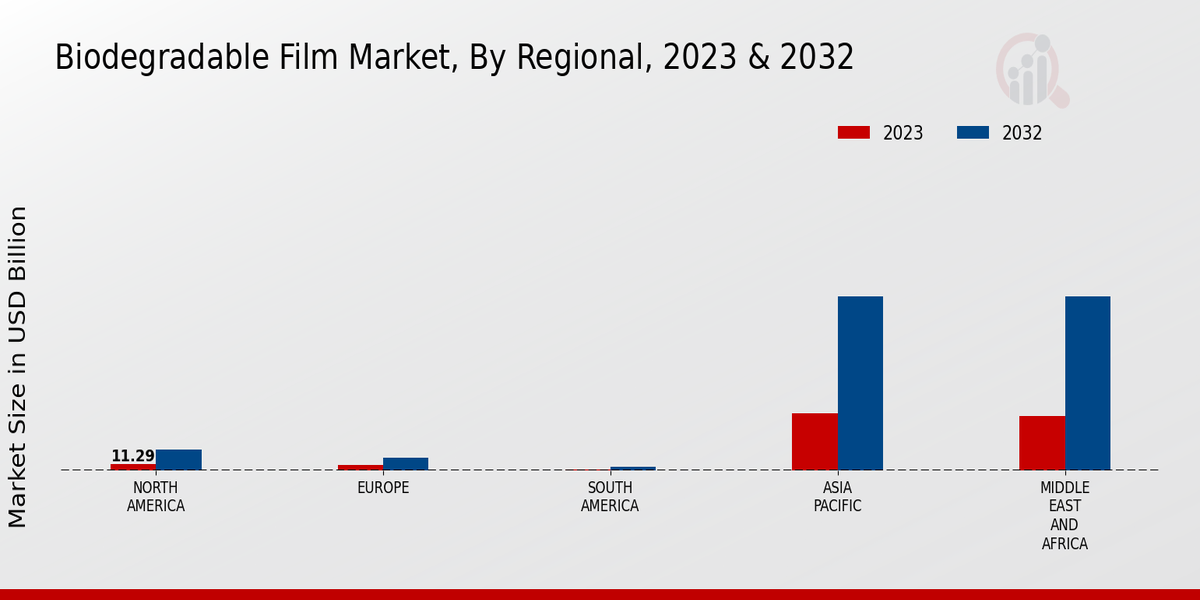Market Growth Projections
The Global Biodegradable Film Market Industry is poised for substantial growth, with projections indicating a market value of 302.4 USD Billion in 2024 and an anticipated increase to 1208.1 USD Billion by 2035. This growth trajectory suggests a robust compound annual growth rate (CAGR) of 13.42% from 2025 to 2035. Such figures underscore the increasing adoption of biodegradable films across various sectors, driven by environmental awareness, regulatory support, and technological advancements. The market's expansion reflects a broader shift towards sustainable practices, positioning biodegradable films as a key component in addressing global plastic pollution challenges.
Rising Environmental Awareness
The increasing global concern regarding environmental sustainability drives the Global Biodegradable Film Market Industry. Consumers are becoming more conscious of the ecological impact of plastic waste, leading to a shift towards biodegradable alternatives. This trend is evident in various regions, where governments are implementing stricter regulations on single-use plastics. For instance, the European Union has set ambitious targets for reducing plastic waste, which has spurred demand for biodegradable films. As a result, the market is projected to grow significantly, with estimates suggesting a value of 302.4 USD Billion in 2024, reflecting a growing preference for sustainable packaging solutions.
Government Regulations and Initiatives
Government policies and initiatives aimed at reducing plastic pollution are pivotal in shaping the Global Biodegradable Film Market Industry. Many countries are enacting legislation that mandates the use of biodegradable materials in packaging and agricultural applications. For example, several states in the United States have introduced bans on certain plastic products, encouraging manufacturers to adopt biodegradable alternatives. This regulatory landscape not only fosters innovation but also enhances market growth. By 2035, the market is expected to reach 1208.1 USD Billion, driven by these supportive policies that promote the adoption of biodegradable films across various sectors.
Growing Demand from Agriculture Sector
The agriculture sector's increasing demand for biodegradable films significantly influences the Global Biodegradable Film Market Industry. Biodegradable mulch films are gaining popularity as they enhance crop yield while minimizing environmental impact. These films decompose naturally, reducing the need for plastic waste disposal. Countries with large agricultural sectors, such as India and Brazil, are adopting these films to promote sustainable farming practices. This trend is likely to bolster market growth, as the agricultural application of biodegradable films is projected to expand, contributing to the overall market value and sustainability goals.
Consumer Preference for Sustainable Products
The shift in consumer preferences towards sustainable products is a driving force in the Global Biodegradable Film Market Industry. As consumers become more environmentally conscious, they actively seek out products that align with their values. This trend is reflected in the packaging industry, where brands are increasingly adopting biodegradable films to meet consumer demands. Companies that prioritize sustainability are likely to gain a competitive edge, as consumers are willing to pay a premium for eco-friendly products. This evolving consumer landscape is expected to further propel the market, fostering innovation and growth in biodegradable film solutions.
Technological Advancements in Material Science
Advancements in material science play a crucial role in the evolution of the Global Biodegradable Film Market Industry. Innovations in biopolymer technology are leading to the development of more efficient and cost-effective biodegradable films. These advancements enable manufacturers to produce films that meet the performance standards of traditional plastics while being environmentally friendly. For instance, the introduction of new bio-based polymers has improved the mechanical properties of biodegradable films, making them suitable for a wider range of applications. This technological progress is expected to contribute to a robust CAGR of 13.42% from 2025 to 2035, indicating a strong future for biodegradable film solutions.














